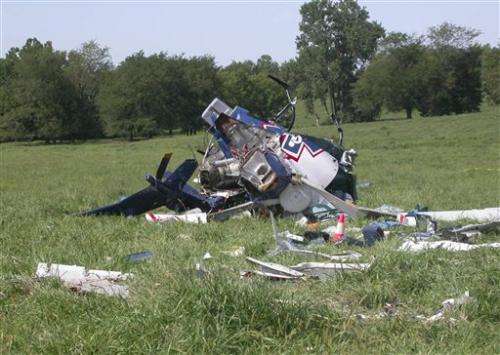US safety board probes case of texting pilot

(AP)—The pilot of a medical helicopter that ran out of fuel and crashed, killing four people, was distracted by text messages when he should have been conducting pre-flight checks, U.S. accident investigators said Tuesday.
The case "juxtaposes old issues of pilot decision making with a 21st-century twist"—distraction by portable electric devices, said National Transportation Safety Board Chairman Deborah Hersman. The board was meeting to determine the cause of the August 2011 accident in the Midwest state of Missouri and to make safety recommendations.
The case is the first fatal commercial aircraft accident investigated by the board in which texting has been implicated. It underscores the board's worries that cellphones and other distracting electronic devices are a growing factor in accidents and incidents across all modes of transportation—planes, trains, cars, trucks and even ships.
The pilot, James Freudenbert, 34, exchanged 20 text messages, mostly with a coworker, over a span of less than two hours before the helicopter crashed into a farm field a little over a mile from an airport where he hoped to refuel, documents made public by board show.
Most of the messaging was with an off-duty female co-worker with whom he had a "long history" of "frequent, intensive communications," and with whom he was planning to have dinner that night, said the board's Bill Bramble.
Freudenbert missed several opportunities to see that the helicopter was low on fuel before he began the first leg of the mission, including apparently failing to conduct a pre-flight check and to look at the craft's fuel gauge.
Three of the messages were sent and five were received while the helicopter was in flight, although not in the final 11 minutes before it crashed, according to a timeline.
Freudenbert also exchanged text messages as he was reporting by radio to a company communications center that the helicopter was low on fuel. The helicopter was on the ground at the time waiting for the patient, who was being transferred from one hospital to another, and a nurse and a paramedic to board.
Although the pilot was not texting at the time of the crash, it is possible the messaging took his mind off his duties and caused him to skip safety steps he might have otherwise performed, said experts on human performance and cognitive distractions. People cannot concentrate on two things at once; they can only shift their attention rapidly back and forth, the experts said. But as they do that, the sharpness of their focus begins to erode.
"People just have a limited ability to pay attention," said David Strayer, a professor of cognitive and neural science at the University of Utah. "It's one of the characteristics of how we are wired."
"If we have two things demanding attention, one will take attention away from other," he said. "If it happens while sitting behind a desk, it's not that big of a problem. But if you are sitting behind the wheel of a car or in the cockpit of an airplane, you start to get serious compromises in safety."
In October 2010, two Northwest Airlines pilots overflew their destination of Minneapolis-St. Paul International Airport by 100 miles (160 kilometers) while they were engrossed in working on flight schedules on their laptops.
A text message—especially one accompanied by an audible alert like a buzz or bell—interrupts a person's thoughts and can be hard to ignore, said Christopher Wickens, a University of Illinois professor emeritus of engineering and aviation psychology. If the subject of the email is especially engaging, or especially emotional, that also makes it hard to ignore, he said.
The helicopter was operated by a subsidiary of Air Methods Corp., the largest provider of air medical emergency transport services in the U.S. The company's policies prohibit the use of electronic devices by pilots during flight.
Freudenbert apparently did not check the amount of fuel on board the helicopter before taking off from the company's base in St. Joseph, Missouri, even though he had been briefed that the aircraft would be low on fuel because it had been used the night before for training exercises. He radioed that he had two hours of fuel shortly after the helicopter was airborne.
But when the helicopter landed less than 10 minutes later in Bethany, Missouri, to pick up the patient, Freudenbert radioed the communications center again to report that the copter was lower on fuel than he had initially thought. He estimated he had about 45 minutes worth of fuel, which investigators said they believe was a lie intended to cover up his earlier omissions. In fact, the helicopter had 30 minutes of fuel left, they said. Federal Aviation Administration regulations require 20 minutes of reserve fuel at all times.
Freudenbert opted to continue the patient transfer to a hospital in Liberty, Missouri, changing plans only enough for a stop at an airfield 32 minutes away for fuel. The helicopter stalled and crashed about a mile from the airfield.
Copyright 2013 The Associated Press. All rights reserved. This material may not be published, broadcast, rewritten or redistributed.


















